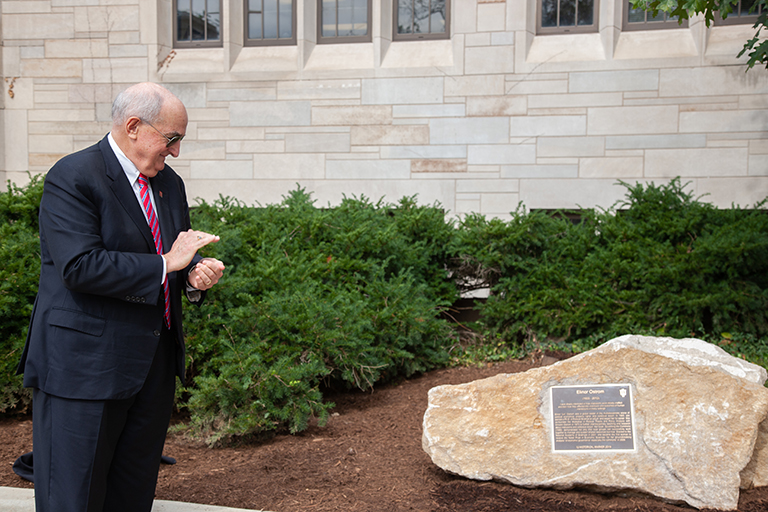A Distinguished Scholar In A Community Of Scholars
Like all great research universities, Indiana University draws its strength from the breadth of its activities. Although there are selected areas of particular focus, its essence is a gathering of scholars from across all disciplines and creative fields, providing a rich environment for faculty and students alike.
Thus, it is fitting that today we dedicate the Bloomington campus’s first Bicentennial historical marker in honor of a pioneering, influential scholar whose life and career brought great distinction to Indiana University, and who, throughout her distinguished career, worked to foster a spirit of interdisciplinary collaboration—the late Professor Elinor Ostrom, known affectionately to her colleagues and friends as “Lin.”
Honoring Elinor Ostrom
Lin was, of course, a pioneer in many ways.
Even before she became the first woman—and the first political scientist—to receive the Nobel Prize in Economics, Lin was known here and around the world as a leading social scientist, and as a gifted, incisive, and creative scholar.
After earning her doctoral degree at UCLA—at a time when there was widespread resistance to admitting women to doctoral programs—Lin came to IU, and the university was incredibly fortunate to have had the benefit of her outstanding work as a teacher, researcher, advisor, and administrator for nearly half a century.
She was one of the primary forces behind the development of the academic study of the commons, but her work was also part of a much larger research project, which included examining the power of civil society, the development of social norms, and the voluntary collective action of citizens to solve problems.
She was also responsible for creating a number of centers that directly shaped the research careers of hundreds of social scientists, the foremost of which is IU’s renowned Ostrom Workshop, which we renamed in honor of Lin and her late husband, Vincent, in 2012.
Lin and Vincent’s legacy lives on at Indiana University through the Workshop, as well as through hundreds of their former graduate students who are now working around the globe as scholars, researchers, development practitioners, and advisors.
And I am very pleased that Lin’s legacy will also permanently live on through the historical marker we dedicate today.
The Elinor Ostrom Statue
In addition, in June, at this year’s Workshop on the Ostrom Workshop, I was delighted to announce that IU has commissioned a statue of Lin, which will also be located here outside of Woodburn Hall. It will be the first statue of a woman on the IU Bloomington campus.
The sculpture will be funded through gifts from members of IU’s Well House Society, a giving society of the IU Foundation, whose members make annual gifts to IU. During the Bicentennial, we are using Well House Society funds with a focus on campus beautification and honoring and preserving IU’s heritage.
I am very pleased to announce today that the sculpture of Lin will be created by Michael McAuley, the same artist who created the Hoagy Carmichael Landmark Sculpture, which is installed just outside the IU Cinema. Mr. McAuley is a native of Bloomington and an IU alumnus. He is also an award-winning artist whose work appears in galleries and installations throughout the United States.
I am very pleased that Mr. McAuley is with us this afternoon—and that his sketch of the planned sculpture of Professor Ostrom is on display here today for the first time. Would you join me in welcoming Mr. McAuley?
All of us look forward to the day when Lin’s statue will join those of other legendary figures in the history of IU and the Bloomington campus, including Hoagy Carmichael, Ernie Pyle, and Herman Wells.
Special Thanks
On behalf of Indiana University, I want to thank a number of people who helped make the installation of the historical marker honoring Professor Ostrom possible.
Professor Ostrom was nominated to be part of the IU Historical Marker Program by the Ostrom Workshop. Margaret Baechtold, the former operations manager of the workshop, led these efforts until her retirement, at which point Emily Castle, the workshop’s assistant director and librarian, took up the charge.
I want to also thank the members of the IU Historical Marker Committee, who reviewed all applications and made recommendations to Provost Lauren Robel and me. The efforts of University Historian and director of the IU Historical Marker Program, Jim Capshew, and members of the staff of the Office of the Bicentennial, including
- Bicentennial Director Kelly Kish,
- Project Manager Jeremy Hackerd,
- Assistant Project Manager Angel Nathan, and
- Professor Capshew’s graduate assistant, Bre Anne Briskey
were instrumental in this process.
I also want to commend Vice President for Capital Planning and Facilities Tom Morrison, IU landscape architect Mia Williams, and associate landscape architect Joel Stevens for their dedicated efforts that helped make this marker possible.
Increasing Our Appreciation Of The Past
Robert Weible, former president of the National Council on Public History, writes that “Like history books or museum exhibits, (historical) markers can increase our appreciation of the past… (Their) principal value,” he continues, “has less to do with the words cast in aluminum and more to do with the process by which people come to understand the meaning of those words.”1
In the years to come, the countless students, faculty, and visitors who pause here to read the words about Elinor Ostrom—cast not in aluminum, but in bronze—will be inspired to understand the meaning of those words and the incredible impact of her life’s work on Indiana University and, indeed, the world.
Source Notes
1. Robert Weible, “The Case of Historical Markers in the Twenty-first Century,” History News Vol. 61, No. 1 (Winter 2006), 23-24.


